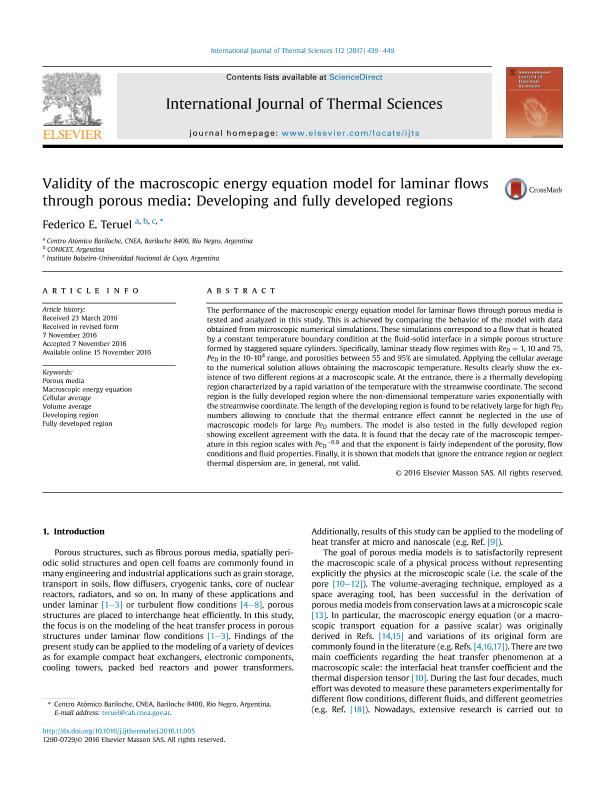Mostrar el registro sencillo del ítem
dc.contributor.author
Teruel, Federico Eduardo

dc.date.available
2019-04-16T18:34:37Z
dc.date.issued
2017-02-15
dc.identifier.citation
Teruel, Federico Eduardo; Validity of the macroscopic energy equation model for laminar flows through porous media: Developing and fully developed regions; Elsevier France-editions Scientifiques Medicales Elsevier; International Journal Of Thermal Sciences; 112; 15-2-2017; 439-449
dc.identifier.issn
1290-0729
dc.identifier.uri
http://hdl.handle.net/11336/74504
dc.description.abstract
The performance of the macroscopic energy equation model for laminar flows through porous media is tested and analyzed in this study. This is achieved by comparing the behavior of the model with data obtained from microscopic numerical simulations. These simulations correspond to a flow that is heated by a constant temperature boundary condition at the fluid-solid interface in a simple porous structure formed by staggered square cylinders. Specifically, laminar steady flow regimes with ReD = 1, 10 and 75, PeD in the 10-104 range, and porosities between 55 and 95% are simulated. Applying the cellular average to the numerical solution allows obtaining the macroscopic temperature. Results clearly show the existence of two different regions at a macroscopic scale. At the entrance, there is a thermally developing region characterized by a rapid variation of the temperature with the streamwise coordinate. The second region is the fully developed region where the non-dimensional temperature varies exponentially with the streamwise coordinate. The length of the developing region is found to be relatively large for high PeD numbers allowing to conclude that the thermal entrance effect cannot be neglected in the use of macroscopic models for large PeD numbers. The model is also tested in the fully developed region showing excellent agreement with the data. It is found that the decay rate of the macroscopic temperature in this region scales with PeD −0.8 and that the exponent is fairly independent of the porosity, flow conditions and fluid properties. Finally, it is shown that models that ignore the entrance region or neglect thermal dispersion are, in general, not valid.
dc.format
application/pdf
dc.language.iso
eng
dc.publisher
Elsevier France-editions Scientifiques Medicales Elsevier

dc.rights
info:eu-repo/semantics/openAccess
dc.rights.uri
https://creativecommons.org/licenses/by-nc-sa/2.5/ar/
dc.subject
Cellular Average
dc.subject
Developing Region
dc.subject
Fully Developed Region
dc.subject
Macroscopic Energy Equation
dc.subject
Porous Media
dc.subject
Volume Average
dc.subject.classification
Otras Ciencias Físicas

dc.subject.classification
Ciencias Físicas

dc.subject.classification
CIENCIAS NATURALES Y EXACTAS

dc.title
Validity of the macroscopic energy equation model for laminar flows through porous media: Developing and fully developed regions
dc.type
info:eu-repo/semantics/article
dc.type
info:ar-repo/semantics/artículo
dc.type
info:eu-repo/semantics/publishedVersion
dc.date.updated
2019-04-11T19:50:07Z
dc.journal.volume
112
dc.journal.pagination
439-449
dc.journal.pais
Francia

dc.journal.ciudad
Paris
dc.description.fil
Fil: Teruel, Federico Eduardo. Consejo Nacional de Investigaciones Científicas y Técnicas. Centro Científico Tecnológico Conicet - Patagonia Norte; Argentina. Comisión Nacional de Energía Atómica. Centro Atómico Bariloche; Argentina. Comisión Nacional de Energía Atómica. Gerencia del Área de Energía Nuclear. Instituto Balseiro; Argentina
dc.journal.title
International Journal Of Thermal Sciences

dc.relation.alternativeid
info:eu-repo/semantics/altIdentifier/url/https://www.sciencedirect.com/science/article/pii/S1290072916303428
dc.relation.alternativeid
info:eu-repo/semantics/altIdentifier/doi/http://dx.doi.org/10.1016/j.ijthermalsci.2016.11.005
Archivos asociados
